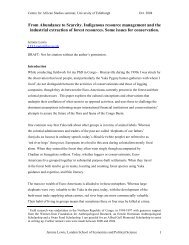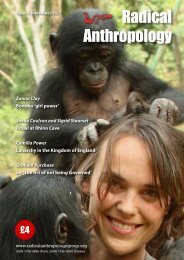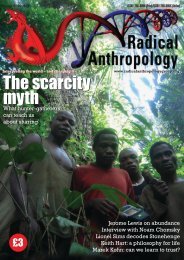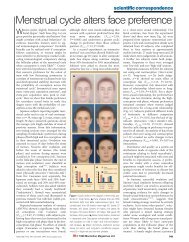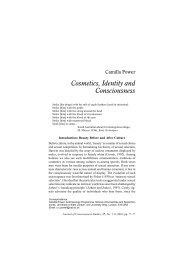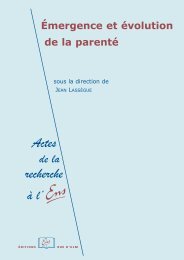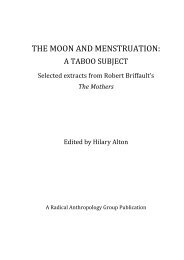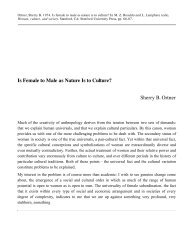Commentary/Locke & Bogin: <str<strong>on</strong>g>Language</str<strong>on</strong>g> <str<strong>on</strong>g>and</str<strong>on</strong>g> <str<strong>on</strong>g>life</str<strong>on</strong>g> <str<strong>on</strong>g>history</str<strong>on</strong>g>language as <strong>the</strong> “product of successive <strong>on</strong>togenies” (p. 10; also seeStuddert-Kennedy 2005).19. This process, <strong>on</strong>ce termed “niche picking” by Scarr <str<strong>on</strong>g>and</str<strong>on</strong>g>McCartney (1983), has recently been treated in some detail byOdling-Smee et al. (2003), who rightly regard “niche c<strong>on</strong>structi<strong>on</strong>”as a vastly underplayed process in <strong>the</strong> <str<strong>on</strong>g>history</str<strong>on</strong>g> of evoluti<strong>on</strong>arythinking. A brief but interesting discussi<strong>on</strong> of nichec<strong>on</strong>structi<strong>on</strong> is available in Dawkins (2004), who distinguishesthis kind of engineered <str<strong>on</strong>g>and</str<strong>on</strong>g> adaptive alterati<strong>on</strong>, which is encompassedby his extended phenotype <strong>the</strong>ory, from <strong>the</strong> lessDarwinian processes of “niche change.”Open Peer CommentaryInvoking narrative transmissi<strong>on</strong> in oralsocietiesIleana BengaThe Folklore Archive Institute in Cluj-Napoca, Romanian Academy,Cluj-Napoca 400015, Romania.ileana_benga@yahoo.itAbstract: The ethnographic descripti<strong>on</strong> of story-telling <str<strong>on</strong>g>and</str<strong>on</strong>g> narrativetransmissi<strong>on</strong> of cultural facts is an aspect of Locke & Bogin’s (L&B’s)article that should be amplified. Innate shared gene patrim<strong>on</strong>y isbiased by <strong>the</strong> kinship structure of particular societies <str<strong>on</strong>g>and</str<strong>on</strong>g> interacts with<strong>the</strong> transmissi<strong>on</strong> of narratives. Trance experiences are ano<strong>the</strong>rinteresting aspect of verbal <str<strong>on</strong>g>and</str<strong>on</strong>g> ag<strong>on</strong>istic “performances.”<str<strong>on</strong>g>Language</str<strong>on</strong>g> acquisiti<strong>on</strong> in both its innate <str<strong>on</strong>g>and</str<strong>on</strong>g> social aspects mustaffect <strong>the</strong> oral transmissi<strong>on</strong> of culture within traditi<strong>on</strong>al societies.The rules of transmissi<strong>on</strong> are certainly a matter for multidisciplinaryinvestigati<strong>on</strong>. Ethnology <str<strong>on</strong>g>and</str<strong>on</strong>g> <strong>the</strong> specific descripti<strong>on</strong> ofstory-telling including performance style <str<strong>on</strong>g>and</str<strong>on</strong>g> c<strong>on</strong>text c<strong>on</strong>stitute<strong>on</strong>ly <strong>on</strong>e level of approach to <strong>the</strong> narrative transmissi<strong>on</strong> ofcultural facts (Degh 1995). Ethnology, however, is uniquelyimportant as an avenue to <strong>the</strong> complex syntax that articulateshuman society <strong>on</strong> both synchr<strong>on</strong>ic <str<strong>on</strong>g>and</str<strong>on</strong>g> diachr<strong>on</strong>ic scales.Essentially, kin groups across cultures strive to reproduce <strong>the</strong>irknowledge across generati<strong>on</strong>s, particularly favoring <strong>the</strong>ir peers of<strong>the</strong> same generati<strong>on</strong>. Ethnologists c<strong>on</strong>centrate <strong>on</strong> recurrent culturalpractices, with <strong>the</strong> supporting genetic relatedness of kindgroups less salient to <strong>the</strong>m. In any case, selecti<strong>on</strong> <strong>on</strong> raw vocalability, improving widely variant types of spoken communicati<strong>on</strong>within <strong>the</strong> kin group in <strong>the</strong> very early stages of human <str<strong>on</strong>g>history</str<strong>on</strong>g> (seesect. 3.5 of <strong>the</strong> target article), seems logically possible, but canhardly be documented.Kinship structures inform <strong>the</strong> mechanisms of cultural transmissi<strong>on</strong>.Natural kinship is accompanied in practically everysociety by cultural kinship (previously called fictive kinship).C<strong>on</strong>ceptually put, natural <str<strong>on</strong>g>and</str<strong>on</strong>g> cultural kinship may lead to twocomplementary genealogies, with memory-carriers <strong>on</strong>ly partiallyoverlapping in each group. Thus, an important patrim<strong>on</strong>y existsthat is not “individually” genetic, but “communitarily” genetic.To insiders following <strong>the</strong> oral prescripti<strong>on</strong>s of a given society,often <strong>the</strong> pers<strong>on</strong>al aspect of informati<strong>on</strong> transmissi<strong>on</strong> is very sec<strong>on</strong>dary.To <strong>the</strong> ethnologist, <strong>the</strong> interesting questi<strong>on</strong> is not about<strong>the</strong> origin of oral transmissi<strong>on</strong>, or about its evoluti<strong>on</strong>ary trajectory,but about its c<strong>on</strong>tent <str<strong>on</strong>g>and</str<strong>on</strong>g> mechanisms, easily searched forin present-day field realities. Ethnographic descripti<strong>on</strong> mustcomplement evoluti<strong>on</strong>ary hypo<strong>the</strong>ses regarding oral culturaltransmissi<strong>on</strong>. Present-day cultures with primarily oral methodsof transmissi<strong>on</strong> have never stopped generating transmissi<strong>on</strong>c<strong>on</strong>tent <str<strong>on</strong>g>and</str<strong>on</strong>g> are far from <strong>the</strong> static models that <strong>the</strong> targetarticle suggests (sect. 4).Ethnographic evidence is richest in <strong>the</strong> following categories ofcultural transmissi<strong>on</strong>: kinship – <strong>the</strong> transgenerati<strong>on</strong>al divisi<strong>on</strong> ofgoods, both material (e.g., dowry, inheritance) <str<strong>on</strong>g>and</str<strong>on</strong>g> spiritual (e.g.,descent <str<strong>on</strong>g>and</str<strong>on</strong>g> widely-accepted instituti<strong>on</strong>s such as god-parenting;Rivers 1907); narratives from belief-tales to fairy-tales; <str<strong>on</strong>g>and</str<strong>on</strong>g>cerem<strong>on</strong>ies – including a wide variety of <str<strong>on</strong>g>life</str<strong>on</strong>g>-cycle or year-cyclecerem<strong>on</strong>ies. All of <strong>the</strong>se kinds of transmissi<strong>on</strong> are observed not<strong>on</strong>ly in <strong>the</strong> case of oral societies, but also in urban <str<strong>on</strong>g>and</str<strong>on</strong>g> literate <strong>on</strong>es.A great deal of attenti<strong>on</strong> is focused in ethnology <strong>on</strong> <strong>the</strong> relati<strong>on</strong>invoked in secti<strong>on</strong>s 4.1 <str<strong>on</strong>g>and</str<strong>on</strong>g> 4.2, between verbal <str<strong>on</strong>g>and</str<strong>on</strong>g> ag<strong>on</strong>isticperformance, <str<strong>on</strong>g>and</str<strong>on</strong>g> power. C<strong>on</strong>tests of brilliant performers instory-telling <str<strong>on</strong>g>and</str<strong>on</strong>g> oral narrative transmissi<strong>on</strong> show <strong>on</strong>ly <strong>on</strong>easpect of cultural transmissi<strong>on</strong>. Ano<strong>the</strong>r aspect is trance, whichis linked to <strong>the</strong> special qualities of precious individuals within<strong>the</strong> community – ano<strong>the</strong>r widespread form of power.Locke & Bogin’s (L&B’s) article c<strong>on</strong>centrates principally <strong>on</strong>individuals c<strong>on</strong>sciously manipulating technical ability forpower. No less powerful, “ordinary” members of oral societiesoften achieve high status using transformed linguistic proficiencyin altered states of c<strong>on</strong>sciousness. I have in mind <strong>the</strong>many techniques of trance, be it ecstatic trance (whose exemplarmodel is <strong>the</strong> classical shaman; Eliade 1951; Humphrey1996), or induced trance (trances without presumed journeyingto o<strong>the</strong>r worlds; De Martino 1961). Both types of trances shareexquisite performances, complete with assistants/interpreters ofoften parallel “languages.” The audience is prepared, <str<strong>on</strong>g>and</str<strong>on</strong>g> <strong>the</strong>performance must fit <strong>the</strong> expectancies of <strong>the</strong> community in<strong>the</strong> form of local myths or legends. For <strong>the</strong> individuals performingin a trance state, <strong>the</strong> ability to significantly change <strong>the</strong>irstate of c<strong>on</strong>sciousness accompanies <strong>the</strong>ir linguistic proficiency;it does not originate in such proficiency. The stories of firsth<str<strong>on</strong>g>and</str<strong>on</strong>g>trance experience surely reinvest local narrative patrim<strong>on</strong>y,after necessarily following its trends in shaping <strong>the</strong>trance/ecstasy experience.<str<strong>on</strong>g>Language</str<strong>on</strong>g> use, not language, is what developsin childhood <str<strong>on</strong>g>and</str<strong>on</strong>g> adolescenceDerek Bickert<strong>on</strong>Department of Linguistics, University of Hawaii, H<strong>on</strong>olulu, HI 96822.derbick@hawaii.rr.com www.derekbickert<strong>on</strong>.comAbstract: That both language <str<strong>on</strong>g>and</str<strong>on</strong>g> novel <str<strong>on</strong>g>life</str<strong>on</strong>g>-<str<strong>on</strong>g>history</str<strong>on</strong>g> stages are unique tohumans is an interesting datum. But failure to distinguish betweenlanguage <str<strong>on</strong>g>and</str<strong>on</strong>g> language use results in an exaggerati<strong>on</strong> of <strong>the</strong> languageacquisiti<strong>on</strong> period, which in turn vitiates claims that <str<strong>on</strong>g>new</str<strong>on</strong>g><strong>development</strong>al stages were causative factors in language evoluti<strong>on</strong>.Locke & Bogin’s (L&B’s) unusually l<strong>on</strong>g target article has providedan unusually thorough account of how <strong>the</strong> <str<strong>on</strong>g>life</str<strong>on</strong>g> cycle ofhumans differs from those of o<strong>the</strong>r primates. Instead of a soluti<strong>on</strong>to <strong>the</strong> puzzle of how <str<strong>on</strong>g>and</str<strong>on</strong>g> why language evolved, however, we areleft with additi<strong>on</strong>al mysteries: how <str<strong>on</strong>g>and</str<strong>on</strong>g> why childhood <str<strong>on</strong>g>and</str<strong>on</strong>g> adolescenceevolved. Fur<strong>the</strong>rmore, L&B fail to make a c<strong>on</strong>vincingcase that any causal c<strong>on</strong>necti<strong>on</strong> exists between novel <strong>development</strong>alstages <str<strong>on</strong>g>and</str<strong>on</strong>g> language evoluti<strong>on</strong>.What selected for childhood? L&B’s best suggesti<strong>on</strong> is that itenabled mo<strong>the</strong>rs to shorten <strong>the</strong> interval between childbirths,hence to have more offspring. But since this is desirable forany species, why did childhood evolve in <strong>on</strong>e primate al<strong>on</strong>e?L&B have no answer. When <strong>the</strong>y come to adolescence, what<strong>the</strong> authors propose does not merely fail to support <strong>the</strong>irclaims, it works against <strong>the</strong>m. They characterize adolescence asa period for young individuals to rehearse adult ec<strong>on</strong>omic,social, <str<strong>on</strong>g>and</str<strong>on</strong>g> sexual behaviors before being burdened with reproductivechores. Why would such behaviors need rehearsalunless <strong>the</strong>y were noticeably more complex than behaviors of280 BEHAVIORAL AND BRAIN SCIENCES (2006) 29:3
Commentary/Locke & Bogin: <str<strong>on</strong>g>Language</str<strong>on</strong>g> <str<strong>on</strong>g>and</str<strong>on</strong>g> <str<strong>on</strong>g>life</str<strong>on</strong>g> <str<strong>on</strong>g>history</str<strong>on</strong>g>o<strong>the</strong>r species? What could have made <strong>the</strong>m more complex if not<strong>the</strong> l<strong>on</strong>g pre-existence of a language <str<strong>on</strong>g>and</str<strong>on</strong>g> a complex culture built<strong>on</strong> it? This suggests that language drove <str<strong>on</strong>g>life</str<strong>on</strong>g>-cycle changes, ra<strong>the</strong>rthan <strong>the</strong> reverse.The timing of <strong>the</strong>se changes remains highly problematic.Virtually all <strong>the</strong> evidence comes from teeth. How <strong>the</strong> owners ofthose teeth were organized, <strong>the</strong>ir modes of subsistence, <strong>the</strong>envir<strong>on</strong>ments <str<strong>on</strong>g>and</str<strong>on</strong>g> ecologies <strong>the</strong>y shared – all <strong>the</strong>se <str<strong>on</strong>g>and</str<strong>on</strong>g> moreremain blank; as in too many works <strong>on</strong> human evoluti<strong>on</strong>, <strong>the</strong>reis very little human evoluti<strong>on</strong>.But <strong>the</strong> major weakness of L&B’s article lies in <strong>the</strong>ir treatmentof language. They seize up<strong>on</strong> <strong>the</strong> distincti<strong>on</strong> by Hauser et al.(2002) between a broad <str<strong>on</strong>g>and</str<strong>on</strong>g> a narrow faculty of language, <str<strong>on</strong>g>and</str<strong>on</strong>g>misinterpret this as licensing <strong>the</strong> subsuming of structural <str<strong>on</strong>g>and</str<strong>on</strong>g>pragmatic elements under a single umbrella. They would haved<strong>on</strong>e better to focus <strong>on</strong> an earlier distincti<strong>on</strong> of Chomsky’sbetween I-language <str<strong>on</strong>g>and</str<strong>on</strong>g> E-language (Chomsky 1980).I(nternal)-language is <strong>the</strong> knowledge of language stored in <strong>the</strong>individual’s brain; E(xternal)-language is <strong>the</strong> sum total oflanguage use in a linguistic community. The first may (<str<strong>on</strong>g>and</str<strong>on</strong>g>probably must) have a biological foundati<strong>on</strong>; <strong>the</strong> sec<strong>on</strong>d isclearly cultural. If evoluti<strong>on</strong> is a biological process, as generallyassumed, any inquiry into language evoluti<strong>on</strong> should address<strong>the</strong> first ra<strong>the</strong>r than <strong>the</strong> sec<strong>on</strong>d. As a minimum, any such studyshould clearly distinguish between <strong>the</strong> language faculty itself<str<strong>on</strong>g>and</str<strong>on</strong>g> <strong>the</strong> uses to which it is put. Nobody would dream of c<strong>on</strong>fusingo<strong>the</strong>r things with <strong>the</strong> uses of those things (e.g., cars with driving,or forks with eating), yet this elementary error occurs repeatedlyin work <strong>on</strong> language evoluti<strong>on</strong>.Jokes, language games, gossip, oratory, extended narrative, <str<strong>on</strong>g>and</str<strong>on</strong>g><strong>the</strong> like are clearly features of language use, whereas ph<strong>on</strong>ology,syntax, morphology, <str<strong>on</strong>g>and</str<strong>on</strong>g> lexic<strong>on</strong> are comp<strong>on</strong>ents of what is usedin <strong>the</strong> executi<strong>on</strong> of <strong>the</strong>se things. Only by lumping <strong>the</strong>se two setstoge<strong>the</strong>r can L&B sustain <strong>the</strong>ir <strong>the</strong>sis that language acquisiti<strong>on</strong>lasts from infancy to adulthood.L&B overestimate <strong>the</strong> time it takes for <strong>the</strong> structural elementsto come <strong>on</strong> line. Stephen Crain <str<strong>on</strong>g>and</str<strong>on</strong>g> o<strong>the</strong>rs (e.g., Crain 1991;Crain & Thornt<strong>on</strong> 1998) have shown by ingenious experimentsthat most if not all aspects of grammar appear by <strong>the</strong> end ofinfancy (if not before; Crain has pointed out that such experimentsd<strong>on</strong>’t work with children under 36 m<strong>on</strong>ths). Of course,older children <str<strong>on</strong>g>and</str<strong>on</strong>g> adolescents use a richer vocabulary <str<strong>on</strong>g>and</str<strong>on</strong>g>l<strong>on</strong>ger <str<strong>on</strong>g>and</str<strong>on</strong>g> more complex sentences. But this results from interacti<strong>on</strong>sbetween an already-established faculty of language <str<strong>on</strong>g>and</str<strong>on</strong>g><strong>the</strong> dem<str<strong>on</strong>g>and</str<strong>on</strong>g>s placed up<strong>on</strong> it by different facets of normal <strong>development</strong>.Life experience ensures that older children <str<strong>on</strong>g>and</str<strong>on</strong>g> adolescentshave more to talk about; intellectual growth enables <strong>the</strong>mto deploy <strong>the</strong>ir full Piagetian deck of reas<strong>on</strong>ing powers; socializati<strong>on</strong>obliges <strong>the</strong>m to use <strong>the</strong>ir linguistic skills in a wide variety ofc<strong>on</strong>texts, each dem<str<strong>on</strong>g>and</str<strong>on</strong>g>ing its own particular, culturally determinedgenres, styles <str<strong>on</strong>g>and</str<strong>on</strong>g> idioms. The “important aspects oflanguage” that L&B in <strong>the</strong>ir Abstract see as requiring “<strong>the</strong>whole of modern <strong>on</strong>togeny” are, without excepti<strong>on</strong>, not aspectsof language at all, but ra<strong>the</strong>r aspects of language use. C<strong>on</strong>sequently<strong>the</strong>ir whole case is seriously weakened.Meanwhile, serious questi<strong>on</strong>s remain. What led <strong>on</strong>e species,but no o<strong>the</strong>r, to break out of <strong>the</strong> mold of animal communicati<strong>on</strong>systems that have proved perfectly adequate for every o<strong>the</strong>rspecies that has ever existed? L&B line up <strong>the</strong> usual suspects –kin selecti<strong>on</strong>, sexual selecti<strong>on</strong>, social selecti<strong>on</strong> – providing noaccount about how <strong>the</strong>se have operated <strong>on</strong> a vast arrayof species without any remotely similar c<strong>on</strong>sequences. How,when, <str<strong>on</strong>g>and</str<strong>on</strong>g> why did <strong>the</strong> prerequisites for even a protolanguage –symbolism, predicati<strong>on</strong>, displacement – emerge? Was <strong>the</strong>re aprotolanguage, <str<strong>on</strong>g>and</str<strong>on</strong>g> if so what was it like, how did it developinto language? Where did syntax come from, was it adaptedfrom something else? If so, what? If not, where do we go from<strong>the</strong>re? It is such highly specific <strong>development</strong>s in language evoluti<strong>on</strong>that have to be accounted for, not just some amorphoussomething called “language.”Is it an odd <str<strong>on</strong>g>and</str<strong>on</strong>g> interesting fact that <strong>the</strong> <strong>on</strong>ly species withlanguage <str<strong>on</strong>g>and</str<strong>on</strong>g> <strong>the</strong> <strong>on</strong>ly species with childhood <str<strong>on</strong>g>and</str<strong>on</strong>g> adolescenceis <strong>the</strong> same species? Of course. Could <strong>the</strong>re be a c<strong>on</strong>necti<strong>on</strong>somewhere? Possibly. But L&B have not yet showed us <strong>on</strong>e.The role of <strong>development</strong>al immaturity <str<strong>on</strong>g>and</str<strong>on</strong>g>plasticity in evoluti<strong>on</strong>David F. Bjorklund <str<strong>on</strong>g>and</str<strong>on</strong>g> Jas<strong>on</strong> GrotussDepartment of Psychology, Florida Atlantic University, Boca Rat<strong>on</strong>, FL 33431.dbjorklu@fau.edu grotuss@msn.comhttp://www.psy.fau.edu/chez/dfb/Abstract: Aspects of cognitive immaturity may serve both to adaptchildren to <strong>the</strong>ir immediate envir<strong>on</strong>ment <str<strong>on</strong>g>and</str<strong>on</strong>g> to prepare <strong>the</strong>m forfuture <strong>on</strong>es. <str<strong>on</strong>g>Language</str<strong>on</strong>g> may have evolved in children’s groups in <strong>the</strong>c<strong>on</strong>text of play. Developmental plasticity provides variability up<strong>on</strong>which natural selecti<strong>on</strong> operates, <str<strong>on</strong>g>and</str<strong>on</strong>g> such plasticity, that likely playedan important role in <strong>the</strong> evoluti<strong>on</strong> of language, characterizes humanchildren today.Locke & Bogin (L&B) should be c<strong>on</strong>gratulated for focusingattenti<strong>on</strong> <strong>on</strong> <strong>the</strong> role that childhood may have played in <strong>the</strong> evoluti<strong>on</strong>of language. Their <strong>the</strong>orizing is c<strong>on</strong>sistent with that of scholarsdating back to <strong>the</strong> nineteenth century <str<strong>on</strong>g>and</str<strong>on</strong>g> c<strong>on</strong>tinuing todaywho postulated a significant role of <strong>on</strong>togeny in phylogeny(e.g., Baldwin 1896; de Beer 1951/1958; Garstang 1922; Gottlieb2002; West-Eberhard 2003). From this <str<strong>on</strong>g>perspective</str<strong>on</strong>g>, evoluti<strong>on</strong> isbest viewed not as a successi<strong>on</strong> of changes in adult form or functi<strong>on</strong>but as a successi<strong>on</strong> of <strong>on</strong>togenies.Natural selecti<strong>on</strong> has surely had as great an impact (or even agreater impact) early in <strong>on</strong>togeny as it has had in adulthood.Adaptive characteristics in <strong>the</strong> adult phenotype do not emergefully formed, but must develop. Most evoluti<strong>on</strong>ary psychologists<str<strong>on</strong>g>and</str<strong>on</strong>g> anthropologists merely give lip service to selective pressuresduring pre-reproductive periods of <strong>the</strong> <str<strong>on</strong>g>life</str<strong>on</strong>g>span in shaping social<str<strong>on</strong>g>and</str<strong>on</strong>g> cognitive abilities that prove adaptive in adulthood. L&B’saccount of <strong>the</strong> evoluti<strong>on</strong> of language provides a refreshing c<strong>on</strong>trast<str<strong>on</strong>g>and</str<strong>on</strong>g> should serve as a model for subsequent <strong>the</strong>orizing<str<strong>on</strong>g>and</str<strong>on</strong>g> experimentati<strong>on</strong> <strong>on</strong> <strong>the</strong> evoluti<strong>on</strong> of language <str<strong>on</strong>g>and</str<strong>on</strong>g> o<strong>the</strong>rabilities that serve an adaptive functi<strong>on</strong> in adulthood.A flexible cognitive system is required for language <str<strong>on</strong>g>and</str<strong>on</strong>g><strong>the</strong> symbolic representati<strong>on</strong> underlying it to evolve. The slowdevelopinghuman brain, with its increased volume relative toour hominid ancestors, afforded <strong>the</strong> plasticity necessary for <strong>the</strong>emergence of <strong>the</strong>se advanced skills. It is children’s brains <str<strong>on</strong>g>and</str<strong>on</strong>g>minds that are <strong>the</strong> most plastic <str<strong>on</strong>g>and</str<strong>on</strong>g> resp<strong>on</strong>sive to envir<strong>on</strong>mentalmodificati<strong>on</strong>s. Moreover, aspects of young children’s immaturecogniti<strong>on</strong>s may be especially adapted to acquiring informati<strong>on</strong>pertinent to <strong>the</strong> niche of childhood (<strong>on</strong>togenetic adaptati<strong>on</strong>s; seeBjorklund 1997), <str<strong>on</strong>g>and</str<strong>on</strong>g> may also serve to prepare children for <str<strong>on</strong>g>life</str<strong>on</strong>g>as adults (deferred adaptati<strong>on</strong>s; Hernández Blasi & Bjorklund2003). Examples of such informati<strong>on</strong> or skills fostered by immaturecogniti<strong>on</strong> that have both immediate <str<strong>on</strong>g>and</str<strong>on</strong>g> deferred benefitsinclude social relati<strong>on</strong>s developed during play <str<strong>on</strong>g>and</str<strong>on</strong>g> language.Although L&B’s account of how language emerges in familyinteracti<strong>on</strong>s during childhood is intriguing, an alternativeaccount is that children invented language in play groups with<strong>the</strong>ir peers (in additi<strong>on</strong> to perfecting it in adolescent groups).Combining words in novel, playful ways may have led not <strong>on</strong>lyto <strong>the</strong> inventi<strong>on</strong> of words, but to early syntax. In this way,language develops not <strong>on</strong>ly within a family, but within a largersocial group. Members of <strong>the</strong>se groups will c<strong>on</strong>tinue to interactthroughout childhood <str<strong>on</strong>g>and</str<strong>on</strong>g> as adults, <str<strong>on</strong>g>and</str<strong>on</strong>g> will later use <strong>the</strong>ircomm<strong>on</strong> language to communicate with <strong>the</strong>ir offspring. Thisprovides a better c<strong>on</strong>text for <strong>development</strong> <str<strong>on</strong>g>and</str<strong>on</strong>g> cross-generati<strong>on</strong>altransmissi<strong>on</strong> of a language than does <strong>the</strong> family.Children’s ability to invent language is seen when <strong>the</strong>y c<strong>on</strong>vertpidgins into creoles in <strong>the</strong> course of <strong>on</strong>e generati<strong>on</strong> (Bickert<strong>on</strong>BEHAVIORAL AND BRAIN SCIENCES (2006) 29:3 281



